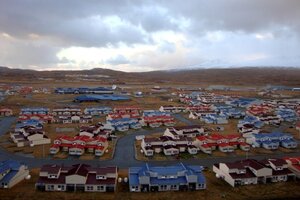Alaska earthquake hits Aleutians: 7.0 magnitude shock
Alaska earthquake hits some 67 miles west of Aleutian Islands, rattling homes and residents. But so far, there are no reports of injuries or damage from the Alaska earthquake.

The town of Adak, Alaska, (seen here in 2010) was shaken Friday, Aug. 30, 2013, by a magnitude-7.0 earthquake. There were no immediate reports of damage or injuries from the Alaska earthquake.
State of Alaska Division of Community & Regional Affairs/AP/File
ANCHORAGE, Alaska
A magnitude-7.0 earthquake rocked Alaska's Aleutian Islands with a jet-like rumble Friday that shook homes and sent residents scrambling for cover.
"I heard it coming," said Kathleen Nevzoroff, who was sitting at her computer in the tiny Aleutians village of Adak when the major temblor struck at 8:25 a.m. local time, getting stronger and stronger. "I ran to my doors and opened them and my chimes were all ringing."
There were no immediate reports of damage or injuries from the earthquake, which occurred in a seismically active region. It was strongly felt in Atka, an Aleut community of 64 people, and the larger Aleutian town of Adak, where 320 people live. The quake was followed by multiple aftershocks, including one measuring magnitude 5.4.
The earthquake didn't trigger a tsunami warning, but Michael Burgy with the West Coast and Alaska Tsunami Warning Center in Palmer, Alaska, said the center is monitoring for potential tsunamis caused by landslides, either on land or under water.
The Alaska Earthquake Information Center said the primary earthquake was centered 67 miles southwest of Adak, about 1,200 miles southwest of Anchorage. Shaking lasted up to one minute.
The quake occurred offshore in the subduction zone where plates of Earth's crust grind and dive. By contrast, California's most famous fault line, the San Andreas, is a strike-slip fault. Quakes along strike-slip faults tend to move horizontally.
In Adak, city clerk Debra Sharrah was upstairs in her two-story townhome getting ready for work when she heard a noise.
"I thought it was my dog running up the stairs," she said. "It kept making noise and then it got louder. So then all of a sudden the rumbling started."
The four-plex of townhomes was shaking and swaying as Sharrah and her dog, Pico, dashed out the door. It seemed like the building moved for a long time, but the only thing disturbed in her home was a stepstool that fell over.
"Nothing fell off my walls, and the wine glasses didn't go out of the hutch or anything," said Sharrah, who moved to the island community from Montana's Glacier National Park area almost two years ago.
In Atka, Nevzoroff manages the village store and expected to find goods had flown off the shelves. But nothing was amiss.
"Everything seems to be okay," she said.
The communities are located in a sparsely populated region and both played roles in World War II.
Atka residents were displaced during the war, relocating to Southeast Alaska so the US government could demolish the village to prevent the Japanese from seizing it as they had other Aleutian communities. After the war, the US Navy rebuilt the community and residents returned. Today, the community is a cluster of solidly built utilitarian buildings scattered over rolling hills that turned emerald green in warmer months.
Adak, 110 miles to the west, had been home to US military installations that allowed forces to wage a successful offense against the Japanese after they seized the Aleutian Islands of Kiska and Attu. After the war, Adak was transformed into a naval air station that served as a submarine surveillance center during the cold war. Later, the facilities were acquired by the Aleut Corp. – a regional native corporation – in a federal land-transfer agreement. It became a city in 2001 and today retains its military appearance.
Associated Press writer Alicia Chang in Los Angeles contributed to this report.

